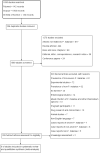Global prevalence and mortality of severe Plasmodium malariae infection: a systematic review and meta-analysis
- PMID: 32736635
- PMCID: PMC7395392
- DOI: 10.1186/s12936-020-03344-z
Global prevalence and mortality of severe Plasmodium malariae infection: a systematic review and meta-analysis
Abstract
Background: Severe complications among patients with Plasmodium malariae infection are rare. This is the first systematic review and meta-analysis demonstrating the global prevalence and mortality of severe P. malariae infection in humans.
Methods: The systematic review and meta-analysis followed the Preferred Reporting Items for Systematic Reviews and Meta-Analyses (PRISMA) guidelines. All research articles published on the severity and mortality of P. malariae infection cases in humans were retrieved from three public databases: PubMed, Scopus, and ISI Web of Science. The pooled prevalence estimate and 95% confidence interval (CI) of complications in patients with P. malariae malaria was analysed using the random-effects model provided in Stata software. The pooled odds ratio (OR) and 95% CI of severe malaria for P. malariae infection and Plasmodium falciparum infection were analysed using Review Manager software.
Results: Six studies were used to estimate the pooled prevalence of severe P. malariae malaria. Out of 10,520 patients infected with P. malariae, the pooled prevalence estimate of severe P. malariae infection was 3% (95% CI 2-5%), with high heterogeneity (I2: 90.7%). Severe anaemia (3.32%), pulmonary complications (0.46%), and renal impairments (0.24%) were the most common severe complications found in patients with P. malariae infection. The pooled proportion of severe anaemia for P. malariae infection and P. falciparum infection was comparable among the four included studies (OR: 0.74, 95% CI 0.22-2.45, I2 = 98%). The pooled proportion of pulmonary complications was comparable between patients with P. malariae infection and those with P. falciparum infection among the four included studies (OR: 1.44; 95% CI 0.17-12.31, I2: 92%). For renal complications, the funnel plot showed that the pooled proportion of renal complications for P. malariae infection and P. falciparum infection was comparable among the four included studies (OR: 0.94, 95% CI 0.18-4.93, I2: 91%). The mortality rate of patients with P. malariae infection was 0.17% (18/10,502 cases).
Conclusions: This systematic review demonstrated that approximately two percent of patients with P. malariae infection developed severe complications, with a low mortality rate. Severe anaemia, pulmonary involvement, and renal impairment were the most common complications found in patients with P. malariae infection. Although a low prevalence and low mortality of P. malariae infection have been reported, patients with P. malariae infection need to be investigated for severe anaemia and, if present, treated aggressively to prevent anaemia-related death.
Keywords: Complications; P. malariae; Quartan malaria; Severe.
Conflict of interest statement
The authors declare that they have no competing interests.
Figures






References
-
- WHO. Malaria. Geneva: World Health Organization; 2019. https://www.who.int/news-room/fact-sheets/detail/malaria. Accessed 10 Jan 2020.
Publication types
MeSH terms
Grants and funding
LinkOut - more resources
Full Text Sources
Medical

